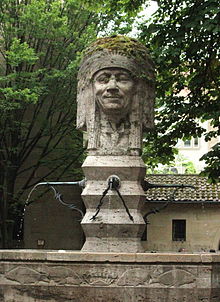Indian well
The Indian fountain is a fountain built between 1924 and 1927 with a double-faced Indian sculpture on the central Werderplatz in Karlsruhe 's Südstadt district .
history
The Indian fountain hides a public toilet system that was newly planned in 1924 , which could not be built completely underground due to the insufficiently deep sewer system and which protrudes about a meter from the ground. It serves as a market fountain for Werderplatz. The design of the Karlsruhe City Planning Director Friedrich Beichel initially envisaged an Indian figure standing above the fountain trough, an allusion to the Indian enthusiasm in the southern part of the city at the time, which may go back to a guest performance by Buffalo Bill in Karlsruhe. After the draft was published in the Karlsruher Tagblatt in 1924 , however, there were violent protests among parts of the population of the district who did not want to be called "Indians", which could also be understood as a disparaging allusion to the dirty faces of the workers in the railway quarter .
The city first had the toilets and the fountain built and opened the facility on July 14, 1925 without the Indian figure. Only after the resistance had subsided, the sculptor August Meyerhuber was commissioned in 1927 to make the travertine fountain stick with sculpture according to Beichel's specifications . The Indian sculpture shows on the south side facing the Johanniskirche the serious face of a Sioux Indian and on the side facing the Gasthaus Wolfbräu opposite the friendly smiling face of the architect Friedrich Beichel. After its final completion on October 11, 1927, the fountain was well received by the general public. Today it is part of the Südstadt coat of arms and is a listed building.
Small Indian well
Also in the south of the city, on a listed facade in Baumeisterstraße, is the small Indian fountain. It was designed by Otto Feist in 1925 on behalf of an entrepreneur after the Indian fountain on Werderplatz had initially been built without the planned Indian figure.
literature
- Gerhard Kabierske: 113 Indian fountains and 114 Indian fountains in Baumeisterstraße. In Heinz Schmitt (Ed.): Monuments, fountains and free sculptures in Karlsruhe 1715–1945 (= publications of the Karlsruhe City Archives, Volume 7). 2nd Edition. Badenia, Karlsruhe 1989, ISBN 3-7617-0264-7 , pp. 583-590 ( PDF, 122 MB ).
- Dietrich Maier: Karlsruhe fountain: pictures - models - photographs. 2004, ISBN 3-89929-022-4 (Indian fountain : No. 75, Indian fountain in Baumeisterstraße: No. 62).
- Katja Förster: Markets and their fountains in Karlsruhe. In: Katja Förster, Markus Gruber, Matthias Maier: Markets and their fountains (= history of houses and buildings. Series of publications by the Karlsruhe City Archives, Volume 11). Info Verlag, Karlsruhe 2011, ISBN 978-3-88190-623-4 , pp. 37-42.
Web links
- Indian fountain in the city lexicon of the Karlsruhe City Archives
- Werderplatz around the Indian fountain (suedstadt.org)
Individual evidence
- ↑ Kabierske: Monuments, fountains and free sculptures in Karlsruhe 1715–1945 , pp. 583–588
- ↑ coat of arms-Südstadt. City of Karlsruhe, accessed on April 5, 2019 .
- ↑ Indian well. In: Database of cultural monuments. City of Karlsruhe, accessed on April 5, 2019 .
- ↑ Kabierske: Monuments, fountains and free sculptures in Karlsruhe 1715–1945 , pp. 588–590
- ↑ Administration building of the Steffelin company with Indian fountain. In: Database of cultural monuments. City of Karlsruhe, accessed on April 5, 2019 .
Coordinates: 49 ° 0 ′ 5.5 ″ N , 8 ° 24 ′ 27.8 ″ E



